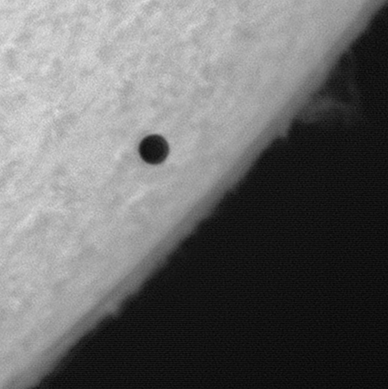9:00 AM (Sunday) | *A rare astronomical event on Monday with the transit of Mercury across the sun*
Paul Dorian
Credit: Tom Polakis of Tempe AZ made this movie of the previous Mercury transit on May 9, 2016 (spaceweather.com).
Overview
A relatively rare astronomical event will take place on Monday, November 11, with the passage of Mercury directly in front of the sun. The jet black and perfectly round Mercury will glide slowly across the solar disk and - given the right sky conditions and a properly safely-filtered telescope - it will be visible in all continents except Australia. The next transit of Mercury won’t take place until 2032. Warning! Do not stare at the sun during transit.
The entire transit of Mercury will be visible om Monday in the eastern US and all of South America; map courtesy eclipsewise.com
Details
One of the biggest astronomy events of the year will take place on Monday, November 11 as the smallest planet Mercury will transit the sun. The transit of Mercury occurs only 13 times each century and the next one won’t occur until 2032 (the next one that will be visible from the continental United States is in 2049). The smallest planet’s eccentric orbit means it doesn’t often pass in front of the Sun from Earth’s vantage point. Transits occur when planets come between us and the Sun, meaning that only two planets can transit: Venus and Mercury. Witnessing a transit is all a matter of timing. Transits of Venus occur in pairs separated by 121.5 or 105.5 years, with eight years separating each transit; the next transit of Venus will occur in the year 2117. Transits of Mercury are far more frequent, since the planet travels on a smaller orbit around the Sun.
On Monday, Mercury will pass directly in front of the sun beginning at 7:35 AM (EST) and the transit will last for almost 6 hours. While the event will be visible in all continents around the world except for Australia, the best place to view the transit – assuming clear skies of course – will be the USA’s Atlantic coast and all of South America where the entire transit will be visible. On the Pacific coast, the transit will already be in progress at sunrise.
Mercury passed directly between the sun and Earth on May 9, 2016 in a transit which lasted seven-and-a-half-hours. Courtesy NASA/GSFC, AP
Warning! Do not start at the sun during transit…do not look at the sun directly with the naked eye, including through binoculars or telescopes. Mercury covers only a tiny fraction of the solar disk so the sun will remain as bright as ever and eye damage can occur. Ordinary eclipse glasses will keep your eyes safe, but they won’t do much to help you see tiny Mercury. The planet is only 1/194th of the sun’s apparent diameter. To watch this event, a safely-filtered telescope with a magnification of 50x or more is recommended. If you do not have a solar filter, images of the transit can be projected onto a wall or screen through an unfiltered telescope, but do not look through the eye piece. According to spaceweather.com, nothing beats a telescope equipped with an H-alpha filter. H-alpha filters are narrowly tuned to the red glow of solar hydrogen. They reveal the sun as a boiling inferno cross-crossed by dark seething magnetic filaments. Here’s a sample H-alpha filtered image taken during the last transit of Mercury on May 9, 2016:
Paul Andrew took this picture from his backyard observatory on May 9, 2016 in St. Margarets at Cliffe, Dover, UK. “The background prominence made Mercury look like it had a comet’s tail,” he says. Image courtesy spaceweather.com
Mercury transits have long been useful tools for scientists. Back in the 17th century, astronomers observed transits of Mercury to try to determine the distance between the Earth and Sun using parallax—observing the transit from two different places on Earth. In addition, scientists have used the transit to indirectly calculate the effect of tidal forces of the Moon on Earth. More recently, one team of scientists used a transit to see whether it would produce a discernible decrease in the amount of sunlight (it did not).
06Z GFS forecast map of “low cloud fraction” on Monday morning, November 11; map courtesy NOAA, tropicaltidbits.com
Weather Outlook
A powerful Arctic cold front will be moving from NW-to-SE on Monday crossing over the Ohio Valley and Great Lakes with clouds and precipitation. Ahead of the front, skies should be at least partly sunny on Monday in the immediate I-95 corridor region from DC-to-Philly-to-NYC along with relatively mild conditions. Perhaps an even better chance for clear skies will take place on Monday to the south and east of the immediate I-95 corridor in places like southern New Jersey and the Delmarva Peninsula. These locations will be a bit farther removed on Monday from the southeastward moving frontal system off to the north and west.
Meteorologist Paul Dorian
Perspecta, Inc.
perspectaweather.com





